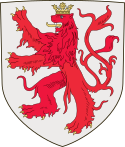
The counts of Limburg ruled a medieval county with its capital at Limbourg-sur-Vesdre, lying between Liège and Aachen. They rose to prominence when one of them was appointed Duke of Lower Lorraine. Though Lorraine was later confiscated, the ducal title was kept within the family, transferred to the county of Limburg, and this was eventually ratified by the Holy Roman Emperor. Thereafter, the dukes of Limburg were one of several claimant lines of heirs to the title of the old duke of Lower Lorraine. Their title was eventually inherited by their competitors, the dukes of Brabant, and became part of the large collection of titles of the Burgundian Netherlands, eventually passing to the Hapsburgs.
After the occupation in 1794 by the French, the old Austrian Duchy of Limburg was disbanded and the largest part was absorbed into the département of Ourthe (which became the province of Liège). Only a small northern part belonged to the département of Meuse-Inférieure and thus to the later province of Limburg. The title "duke of Limburg" was nevertheless revived after the foundation of the new Duchy of Limburg as a result of the Treaty of London in 1839. According to this treaty the new duchy (without the cities of Maastricht and Venlo), was joined to the German Confederation. After the collapse of this confederation in 1866, Limburg as a duchy ceased to exist and became a province of the Kingdom of the Netherlands.
